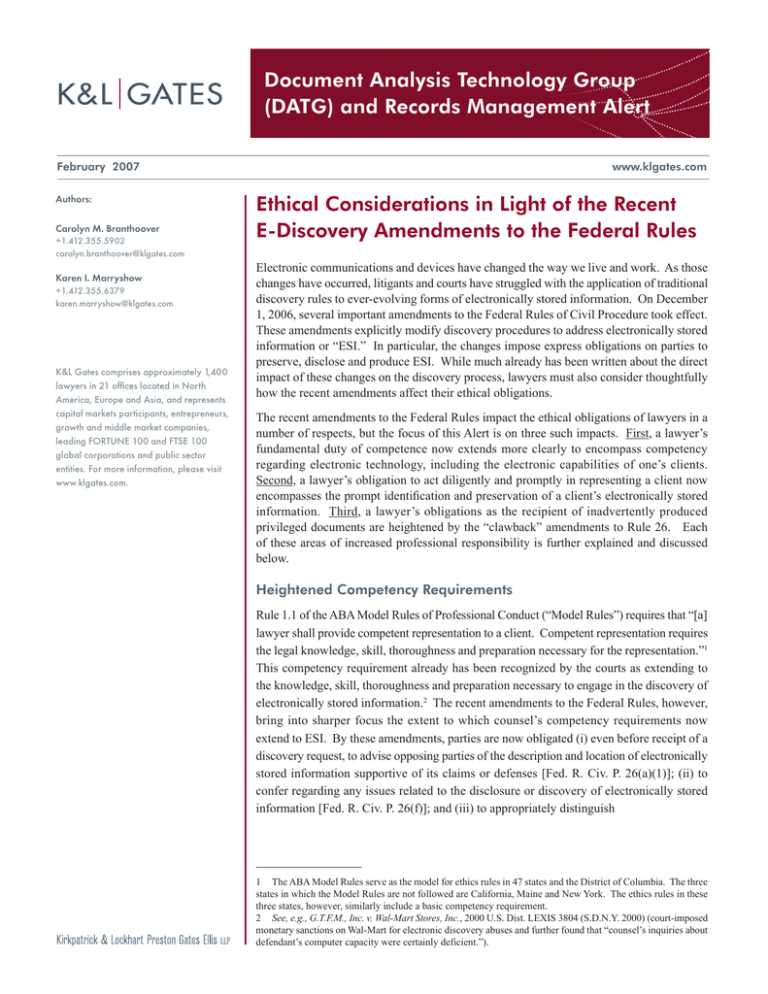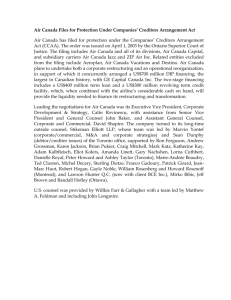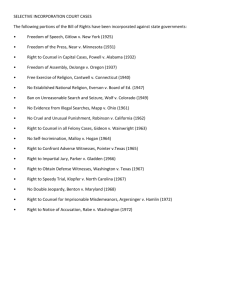
Document Analysis Technology Group
(DATG) and Records Management Alert
February 2007
Authors:
Carolyn M. Branthoover
+1.412.355.5902
carolyn.branthoover@klgates.com
Karen I. Marryshow
+1.412.355.6379
karen.marryshow@klgates.com
K&L Gates comprises approximately 1,400
lawyers in 21 offices located in North
America, Europe and Asia, and represents
capital markets participants, entrepreneurs,
growth and middle market companies,
leading FORTUNE 100 and FTSE 100
global corporations and public sector
entities. For more information, please visit
www.klgates.com.
www.klgates.com
Ethical Considerations in Light of the Recent
E-Discovery Amendments to the Federal Rules
Electronic communications and devices have changed the way we live and work. As those
changes have occurred, litigants and courts have struggled with the application of traditional
discovery rules to ever-evolving forms of electronically stored information. On December
1, 2006, several important amendments to the Federal Rules of Civil Procedure took effect.
These amendments explicitly modify discovery procedures to address electronically stored
information or “ESI.” In particular, the changes impose express obligations on parties to
preserve, disclose and produce ESI. While much already has been written about the direct
impact of these changes on the discovery process, lawyers must also consider thoughtfully
how the recent amendments affect their ethical obligations.
The recent amendments to the Federal Rules impact the ethical obligations of lawyers in a
number of respects, but the focus of this Alert is on three such impacts. First, a lawyer’s
fundamental duty of competence now extends more clearly to encompass competency
regarding electronic technology, including the electronic capabilities of one’s clients.
Second, a lawyer’s obligation to act diligently and promptly in representing a client now
encompasses the prompt identification and preservation of a client’s electronically stored
information. Third, a lawyer’s obligations as the recipient of inadvertently produced
privileged documents are heightened by the “clawback” amendments to Rule 26. Each
of these areas of increased professional responsibility is further explained and discussed
below.
Heightened Competency Requirements
Rule 1.1 of the ABA Model Rules of Professional Conduct (“Model Rules”) requires that “[a]
lawyer shall provide competent representation to a client. Competent representation requires
the legal knowledge, skill, thoroughness and preparation necessary for the representation.”
This competency requirement already has been recognized by the courts as extending to
the knowledge, skill, thoroughness and preparation necessary to engage in the discovery of
electronically stored information. The recent amendments to the Federal Rules, however,
bring into sharper focus the extent to which counsel’s competency requirements now
extend to ESI. By these amendments, parties are now obligated (i) even before receipt of a
discovery request, to advise opposing parties of the description and location of electronically
stored information supportive of its claims or defenses [Fed. R. Civ. P. 26(a)(1)]; (ii) to
confer regarding any issues related to the disclosure or discovery of electronically stored
information [Fed. R. Civ. P. 26(f)]; and (iii) to appropriately distinguish
The ABA Model Rules serve as the model for ethics rules in 47 states and the District of Columbia. The three
states in which the Model Rules are not followed are California, Maine and New York. The ethics rules in these
three states, however, similarly include a basic competency requirement.
See, e.g., G.T.F.M., Inc. v. Wal-Mart Stores, Inc., 2000 U.S. Dist. LEXIS 3804 (S.D.N.Y. 2000) (court-imposed
monetary sanctions on Wal-Mart for electronic discovery abuses and further found that “counsel’s inquiries about
defendant’s computer capacity were certainly deficient.”).
Document Analysis Technology Group
(DATG) and Records Management Alert
between electronically stored information that is
reasonably accessible from that which is not [Fed.
R. Civ. P. 26(b)]. Moreover, counsel of record shares
responsibility with her client for compliance with these
obligations [Fed. R. Civ. P. 26(f)].
Several years ago, in a series of groundbreaking
decisions in Zubulake v. UBS Warburg LLC, District
Judge Scheindlin of the United States District Court for
the Southern District of New York analyzed, in great
detail, discovery obligations related to the production
of e-mail records. Judge Scheindlin’s decisions set
the standards by which electronic discovery practices,
including counsel’s obligations to supervise and monitor
discovery, are now often judged; and those standards
are incorporated in many respects into the recently
amended Federal Rules. With respect to attorney
competency, Zubulake V made clear that a lawyer’s
competency extends to “becom[ing] fully familiar
with her client’s document retention policies, as well
as the client’s data retention architecture.” This same
expectation of competency is now incorporated into the
requirements of Federal Rule 26. Thus, lawyers must
know how their clients create and use electronically
stored information; how they save it; and how it may
be deleted or lost – all so that discoverable ESI can be
properly disclosed, preserved and produced. This may
require extensive investigation by counsel, including
interviews of information technology personnel as
well as “key players” in the litigation, but there is no
longer any question that counsel is obligated to become
reasonably knowledgeable about her client’s electronic
information and related technology.
A recent decision underscores the considerable risks
faced by counsel should they ignore their obligation
to be knowledgeable regarding their clients’ ESI. In
Coleman (Parent) Holdings, Inc. v. Morgan Stanley &
Co., Inc., a Florida state court found that defendant
Morgan Stanley had engaged in numerous discovery
Judge Scheindlin issued seven (7) published opinions in the
Zubulake case. The most frequently cited are Zubulake v. UBS
Warburg LLC, 220 F.R.D. 212 (S.D.N.Y. 2003) (referred to as
“Zubulake IV”) and Zubulake v. UBS Warburg LLC, 229 F.R.D. 422
(S.D.N.Y. 2004) (referred to as “Zubulake V”).
Zubulake V, 229 F.R.D. at 432.
2005 WL 674885 (Fla. Cir. Ct. 2005).
abuses in connection with e-mail production and
imposed one of the harshest sanctions available, i.e.,
that an adverse inference instruction be read to the
jury at trial. Additionally, the court found that Morgan
Stanley’s counsel misrepresented the cost of retrieving
and producing certain e-mails and allowed false
certificates of discovery compliance to be submitted
to the court. The court also criticized defense counsel
for having “carefully crafted” responses to discovery
inquiries so as to avoid disclosure of the existence of
certain ESI and to avoid “outright lying.” The court
was so disturbed by counsel’s involvement in Morgan
Stanley’s “deliberate” and “contumacious” violation
of its discovery obligations that it revoked the pro hac
vice admission of lead defense counsel.
Lawyers are on notice. Their obligation to provide
competent representation in litigation now encompasses
reasonable knowledge, skill, thoroughness and
preparation regarding a client’s ESI and related
technology.
Heightened Diligence Obligations
Model Rule 1.3 provides that “[a] lawyer shall act with
reasonable diligence and promptness in representing a
client.” Additionally, Model Rule 3.4 requires that a
lawyer shall not “fail to make reasonably diligent effort
to comply with a legally proper discovery request by
an opposing party” and shall not “unlawfully obstruct
another party’s access to evidence or unlawfully
alter, destroy or conceal a document or other material
having potential evidentiary value.” The speed with
which electronically stored information is created and
altered and the diversity of computer systems and
programs used to automatically store and delete such
information dramatically impacts a lawyer’s obligations
to act diligently with respect to the preservation of
discoverable ESI.
Coleman (Parent) Holdings, 2005 WL 674885 at *6.
Coleman (Parent) Holdings, 2005 WL 674885 at *10. In a
subsequent proceeding, counsel, by arguing that he was deprived of
notice and an opportunity to be heard, was successful in having the
revocation of his pro hac vice admission stricken, Clare v. Coleman
(Parent) Holdings, Inc., 928 So.2d 1246 (Fla. 2006), but that is
small comfort given the trial court’s harsh criticism of counsel’s
behavior.
February 2007 | Document Analysis Technology Group
(DATG) and Records Management Alert
Recently amended Federal Rule 26(b)(1) requires that
all potentially relevant evidence, specifically including
ESI, be preserved. As explained in Zubulake IV, this
obligation attaches at the moment a party reasonably
anticipates litigation. At that time, the party “must
suspend its routine document retention/destruction
policy and put in place a ‘litigation hold’ to ensure
the preservation of relevant documents.” As further
explained in Zubulake V, counsel shares in these
obligations and is required to:
•Oversee the client’s implementation and
compliance with a “litigation hold” designed to
preserve all relevant evidence;
•Make certain that all sources of potentially relevant
information are identified and placed “on hold;”
•Become fully familiar with the client’s document
retention policies, as well as the client’s data
retention systems; and
•Take affirmative steps to monitor the client’s
production of relevant documents.
The Zubulake V court was confronted with the
defendant’s failure to preserve a number of relevant email files. The court was extremely critical of both the
defendant and its counsel, finding that “counsel failed
to properly oversee UBS in a number of important
ways, both in terms of its duty to locate relevant
information and its duty to preserve and timely produce
that information.”10 Further, the court concluded that
while “UBS personnel deleted e-mails, copies of many
of these e-mails were lost or belatedly produced as a
result of counsel’s failures.”11 The price paid for these
failures was steep. The court imposed sanctions that
included an adverse inference instruction with respect
to e-mails deleted and irretrievably lost and payment of
the costs of any depositions or re-depositions required
by the late productions.
The Zubulake V court refrained from imposing
sanctions upon defense counsel, but defense counsel
10
11
Zubulake IV, 220 F.R.D. at 218.
Zubulake V, 229 F.R.D. at 432.
Zubulake V, 229 F.R.D. at 435.
Zubulake V, 229 F.R.D. at 436.
were not as lucky in Phoenix Four, Inc. v. Strategic
Resources Corp., 2006 U.S. Dist. LEXIS 32211
(S.D.N.Y. 2006). In Phoenix Four, despite notice of
pending litigation, defendants failed to search a number
of computer workstations to determine whether they
contained information related to the litigation. In
seeking sanctions following the late production of
ESI amounting to hundreds of boxes of documents,
the plaintiff claimed that both the defendants and their
counsel had failed to conduct a reasonable and timely
inspection of computers and servers in defendant’s
possession.12 The court found both defendants and
counsel to have been remiss. With respect to defense
counsel’s behavior in particular, the court found
that their lack of diligence was “grossly negligent”
when they failed to inquire sufficiently of their client
regarding the disposition of office computers.13 The
court imposed monetary sanctions that it further
ordered were to be borne by the defendants and their
counsel equally.14
The message is clear. ESI presents unique risks of
discoverable information being lost, and these unique
risks heighten the diligence required of lawyers to take
immediate action to prevent the loss of relevant ESI as
soon as litigation arises or is reasonably anticipated.
Heightened Protection for the
Heightened Risks of Inadvertent
Production
Model Rule 4.4(b) requires that “[a] lawyer who
receives a document relating to the representation of
the lawyer’s client and knows or reasonably should
know that the document was inadvertently sent shall
promptly notify the sender.” The risk of inadvertent
production is heightened in the context of ESI simply
because the sheer volume of ESI produced in discovery
can be massive. In recognition of this heightened
risk, recently amended Federal Rule 26(b)(5) includes
a “clawback” procedure for handling inadvertently
produced information. By this amendment, a party’s
12 Phoenix Four, 2006 U.S. Dist. LEXIS 32211 at *14-15.
13 Phoenix Four, 2006 U.S. Dist. LEXIS 32211 at *20.
14 Phoenix Four, 2006 U.S. Dist. LEXIS 32211 at *28.
February 2007 | Document Analysis Technology Group
(DATG) and Records Management Alert
inadvertent production of privileged information is
protected and specific procedures are established for
handling such inadvertent productions. For those who
are required to produce large quantities of ESI and
may have limited time to conduct a thorough privilege
review, the “clawback” procedures are an important
new protection. Model Rule 4.4(b) and Federal Rule
26(b)(5), however, do not complement each other well,
and this is an area where further developments can be
expected. For example, in today’s digital environment,
a party’s obligations and its counsel’s obligations
with respect to metadata are not clear. Metadata is
data about data. More importantly, it is usually data
that is not apparent on the face of a particular record.
Metadata may reflect information about who created
a document, who edited it, when changes were made,
and what changes were made. Parties who receive
records of a type likely to contain metadata are often
able to engage in “metadata mining.” What is not
clear is whether a party is free to assume that metadata
was intentionally produced (and thus is free to “mine”
it and take advantage of it) or whether a party must
assume that it was inadvertently produced (and thus,
if privileged, must return it pursuant to the “clawback”
provisions of Federal Rule 26(b)(5)).
Confusing matters further, those states that have
considered the ethical implications of metadata mining
have reached differing conclusions. The Model Rules
contain no specific rules prohibiting it, 15 and the
Maryland Bar Association has issued an ethics opinion
stating that “there is no ethical violation” if a lawyer
15 American Bar Association Formal Opinion 06-442 (August 5,
2006).
“reviews or makes use of the metadata without first
ascertaining whether the sender intended to include
such metadata.”16 In contrast, however, the New
York Bar Association has issued an ethics opinion
prohibiting lawyers from “mak[ing] use of computer
software applications to surreptitiously ‘get behind’
visible documents or to trace e-mail.”17 The Florida
Bar Association has reached a conclusion similar to that
of New York.18 With respect to metadata, therefore,
counsel’s obligations remain either uncharted or
dramatically different depending upon which state’s
law applies.
Conclusion
As the Zubulake V court cautioned: “Now that the
key issues have been addressed and national standards
are developing, parties and their counsel are fully on
notice of their responsibility to preserve and produce
electronically stored information.” 19 Counsel’s
obligations in this regard derive from their ethical
obligations to represent a client’s interests competently
and diligently. Those obligations are not new. The
world in which they apply, however, has changed
dramatically and will continue to do so. Counsel, in
order to satisfy their ethical obligations and the newly
amended Federal Rules are required to stay abreast of
those changes.
16 Maryland State Bar Association, Committee on Ethics, Opinion
2007-092 (November 2006). What remains unclear is whether the
Maryland Bar Association would reach a different conclusion if the
metadata contained privileged information.
17 New York State Bar Association, Committee on Professional
Ethics, Opinion 749 (December 14, 2001).
18 Florida Bar Association, Ethics Committee Opinion 06-02
(September 15, 2006).
19 Zubulake V, 229 F.R.D. at 440.
February 2007 | Document Analysis Technology Group
(DATG) and Records Management Alert
K&L Gates comprises multiple affiliated partnerships: a limited liability partnership with the full name Kirkpatrick & Lockhart Preston Gates Ellis LLP qualified
in Delaware and maintaining offices throughout the U.S., in Berlin, and in Beijing (Kirkpatrick & Lockhart Preston Gates Ellis LLP Beijing Representative
Office); a limited liability partnership (also named Kirkpatrick & Lockhart Preston Gates Ellis LLP) incorporated in England and maintaining our London
office; a Taiwan general partnership (Kirkpatrick & Lockhart Preston Gates Ellis) which practices from our Taipei office; and a Hong Kong general
partnership (Kirkpatrick & Lockhart Preston Gates Ellis, Solicitors) which practices from our Hong Kong office. K&L Gates maintains appropriate registrations
in the jurisdictions in which its offices are located. A list of the partners in each entity is available for inspection at any K&L Gates office.
This publication/newsletter is for informational purposes and does not contain or convey legal advice. The information herein should not be used or relied
upon in regard to any particular facts or circumstances without first consulting a lawyer.
Data Protection Act 1998—We may contact you from time to time with information on Kirkpatrick & Lockhart Preston Gates Ellis LLP seminars and with our
regular newsletters, which may be of interest to you. We will not provide your details to any third parties. Please e-mail london@klgates.com if you would
prefer not to receive this information.
©1996-2007 Kirkpatrick & Lockhart Preston Gates Ellis LLP. All Rights Reserved.
February 2007 |




